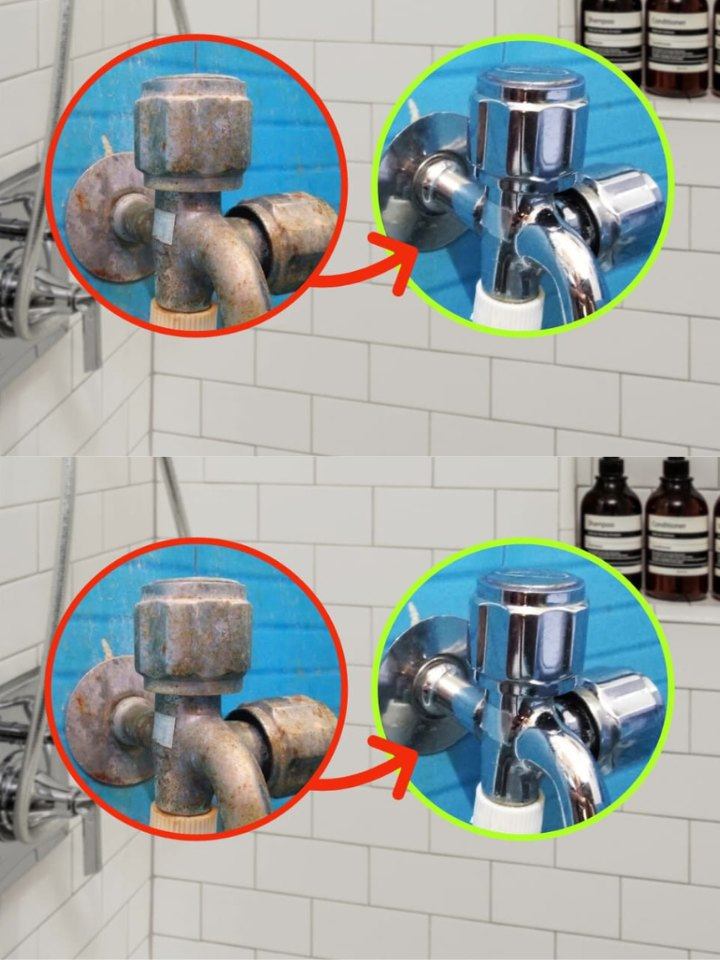ADVERTISEMENT
– **For the faucet**: Spray the vinegar generously on the affected areas around the faucet. Let it sit for 5–10 minutes so the vinegar can work its magic and soften the limescale.
– **For showerheads**: If the limescale buildup is on the showerhead, soak a **plastic bag** in vinegar and carefully place it over the showerhead. Use **rubber bands** to secure the bag in place and let it sit for 30 minutes to an hour, allowing the vinegar to loosen the limescale.
#### Step 3: Scrub the Faucet
After allowing the vinegar to sit, take an **old toothbrush** or a soft-bristle brush and gently scrub the faucet. Focus on areas where you can see or feel the buildup. For stubborn spots, you can sprinkle a little **baking soda** on the brush or directly on the faucet before scrubbing. Baking soda is a mild abrasive that works with vinegar to loosen the limescale without scratching your faucet.
Be sure to scrub all areas, including the faucet handles and any crevices where limescale might have accumulated. Use gentle circular motions to avoid damaging the finish.
#### Step 4: Wipe Away the Buildup
After scrubbing, use a **microfiber cloth** or a clean towel to wipe away the vinegar and loosened limescale. You’ll likely see the white residue transfer onto the cloth as you wipe, leaving the faucet looking cleaner.
#### Step 5: Rinse and Dry
Rinse the faucet thoroughly with warm water to remove any remaining vinegar and debris. Dry the faucet with a clean, dry microfiber cloth to restore its shine.
#### Step 6: Repeat if Necessary
If the limescale buildup is particularly stubborn, repeat the process. You may need to soak the faucet in vinegar for a longer period or apply more elbow grease when scrubbing. For hard-to-reach spots or showerheads, re-soak the plastic bag in vinegar and let it sit for an additional 30 minutes.
### Additional Tips for Maintaining Limescale-Free Faucets
– **Regular Cleaning**: To prevent limescale from building up again, clean your shower faucet once a week with vinegar and water. This will help to keep hard water deposits at bay and maintain the shine of your faucet.
– **Use a Water Softener**: Installing a **water softener** or a **filter** for your showerhead can help reduce the hardness of the water, which will decrease the amount of limescale buildup in the future.
– **Dry the Faucet After Use**: Wipe down the faucet after each shower to remove any leftover water. This simple step can prevent water from evaporating and leaving behind mineral deposits.
– **Lemon Juice Alternative**: If you don’t have vinegar on hand, **lemon juice** can also work to break down limescale. Simply apply fresh lemon juice to the affected area and follow the same steps as with vinegar.
### Why This Method Works
– **Vinegar** is an acid, which helps break down the minerals in limescale. Its natural properties make it an effective and eco-friendly cleaner for a variety of household tasks.
– **Baking soda** acts as a mild abrasive, helping to scrub away the buildup without damaging your faucet. It also helps neutralize any lingering odors from the vinegar.
– **Regular maintenance** keeps limescale from becoming a persistent problem. If you stay on top of cleaning, you won’t have to deal with large buildups that require extensive cleaning sessions.
### Final Thoughts
Cleaning limescale from your shower faucet doesn’t have to be a daunting task. With a few simple ingredients like **white vinegar**, **baking soda**, and a bit of elbow grease, you can restore your faucet to its shiny, like-new condition. Regular cleaning and maintenance will ensure that your faucet stays free of limescale, keeping your bathroom looking fresh and your water flow intact.
By using this natural method, you not only save money on harsh chemicals but also contribute to a more eco-friendly and sustainable cleaning routine. Say goodbye to limescale and hello to a sparkling shower faucet!
ADVERTISEMENT
